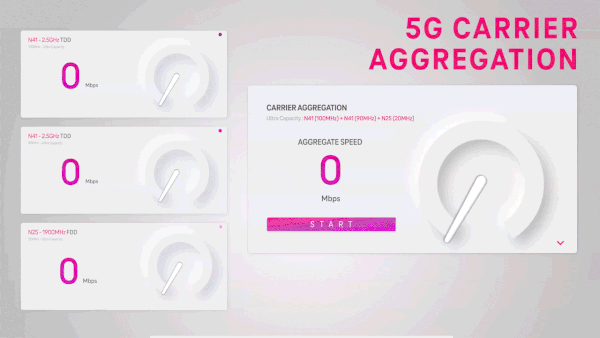T-Mobile's mid-band 5G speeds past 3 Gbps on a Samsung Galaxy S22
Sprint crawled so T-Mobile could sprint.

What you need to know
- T-Mobile hit 3 Gbps speeds with its standalone 5G network using three bands together thanks to 5G carrier aggregation (NR CA).
- T-Mobile's NR CA used two 2.5GHz bands and a 1.9GHz band together to achieve this result.
- The test was completed on a Samsung Galaxy S22 and the upgraded connection is expected to be available to customers later this year.
T-Mobile has accumulated a massive amount of mid-band spectrum and has made sure that not a single bit of it has gone to waste by building the largest 5G network in the county. Continuing this trend, T-Mobile announced that it has topped 3 Gbps download speeds using 5G carrier aggregation (NR CA) to combine three 5G bands. This test used production hardware and a commercial device to achieve these speeds.
With two bands using its 2.5GHz spectrum (band n41) and the third using 1.9GHz spectrum (band n25), T-Mobile is achieving speeds previously only seen on mmWave 5G without the coverage sacrifices of mmWave. Interestingly, this is the spectrum T-Mobile acquired through its purchase of Sprint.
T-Mobile has combined two n41 channels with 100MHz and 90MHz of spectrum plus an n25 channel with 20MHz of spectrum. Altogether, T-Mobile is using 210MHz of spectrum to achieve these speeds.

T-Mobile points out that this result is only possible on a standalone 5G network (SA 5G) which the carrier was the first to launch two years ago. T-Mobile has already been using two-band NR CA in parts of the country with n41 spectrum to increase speeds but has yet to deploy the third n25 band. Alone, these bands can deliver decent transmission speeds but using all three takes things to another level.
President of technology for T-Mobile, Neville Ray, praised the test.
"This test demonstrates the incredible power of mid-band spectrum and represents another huge step forward for standalone 5G. Only T-Mobile is delivering a nationwide standalone 5G network to customers today, and we're blazing a trail with new performance-boosting capabilities that generate incredible speeds and deliver on our vision to create the highest capacity network in the country."
Perhaps one of the more exciting aspects of the test is that it didn't require a truck full of equipment or proprietary to pull off. T-Mobile completed the test using a Samsung Galaxy S22 using the Snapdragon 8 Gen 1 chipset with the Snapdragon X65 Modem-RF System. The Galaxy S22, which is one of the best Android phones you can buy, will be one of the first to be able to use the third NR CA band later in the year. Other devices will also be added as well.
Get the latest news from Android Central, your trusted companion in the world of Android
This compatibility with existing devices will help T-Mobile to make the most of this extra capacity as soon as it's deployed.
One of T-Mobile's biggest strengths continues to be its mid-band 5G, and the carrier is leaning into it. T-Mobile launched the ability to make and receive phone calls on its 5G network with VoNR earlier this month. T-Mobile currently covers 315 million people with its low-band Extended Range 5G and 225 million with its faster Ultra Capacity 5G using mid-band spectrum. T-Mobile is adding more coverage and expects to cover 260 million people with Ultra Capacity 5G in 2022 and 300 million in 2023.

The Galaxy S22 is one of Samsung's best Android phones yet with a powerful Snapdragon 8 Gen 1 CPU and some of the best cameras on any phone. The S22 also supports 5G on every major carrier including mid-band and mmWave coverage.

When Samuel is not writing about networking or 5G at Android Central, he spends most of his time researching computer components and obsessing over what CPU goes into the ultimate Windows 98 computer. It's the Pentium 3.
